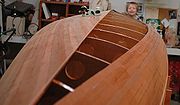
Strip-built
Encyclopedia

Boat building
Boat building, one of the oldest branches of engineering, is concerned with constructing the hulls of boats and, for sailboats, the masts, spars and rigging.-Parts:* Bow - the front and generally sharp end of the hull...
commonly used for canoe
Canoe
A canoe or Canadian canoe is a small narrow boat, typically human-powered, though it may also be powered by sails or small electric or gas motors. Canoes are usually pointed at both bow and stern and are normally open on top, but can be decked over A canoe (North American English) or Canadian...
s and kayak
Kayak
A kayak is a small, relatively narrow, human-powered boat primarily designed to be manually propelled by means of a double blade paddle.The traditional kayak has a covered deck and one or more cockpits, each seating one paddler...
s, but also suitable for larger boat
Boat
A boat is a watercraft of any size designed to float or plane, to provide passage across water. Usually this water will be inland or in protected coastal areas. However, boats such as the whaleboat were designed to be operated from a ship in an offshore environment. In naval terms, a boat is a...
s. The process involves securing narrow, flexible strips of wood edge-to-edge around temporary forms.
The forms are cut as a series of cross-sections of the final design and set up along a "strong back" or other solid base. Stripping begins at the gunwale and finishes with "the football". The strips are edge-glued to each other, being held in place with nails or staples to the forms. When the glue has dried, the nails/staples are removed and the rough hull is sanded smooth. It is then covered with a resin/epoxy impregnated overlay of fiberglass
Fiberglass
Glass fiber is a material consisting of numerous extremely fine fibers of glass.Glassmakers throughout history have experimented with glass fibers, but mass manufacture of glass fiber was only made possible with the invention of finer machine tooling...
cloth, which is sanded and finished before removing the hull from the forms. The inside is then smoothed and similarly reinforced before seats, thwarts, and gunwales, are added to complete the boat.
This process is similarly suited to building kayaks. The strips are stapled onto a number of chipboard forms, the structures is sanded and fibreglassed, then the forms are removed and the hull is attached.
In the 1950s, this process for building canoes was adapted from ship/boat building techniques, and refined by a group of Minnesota canoe racers; primarily Eugene Jensen, Irwin C.(Buzzy) Peterson, and Karl Ketter.

